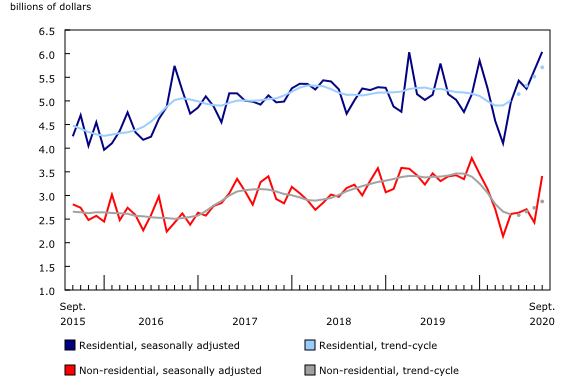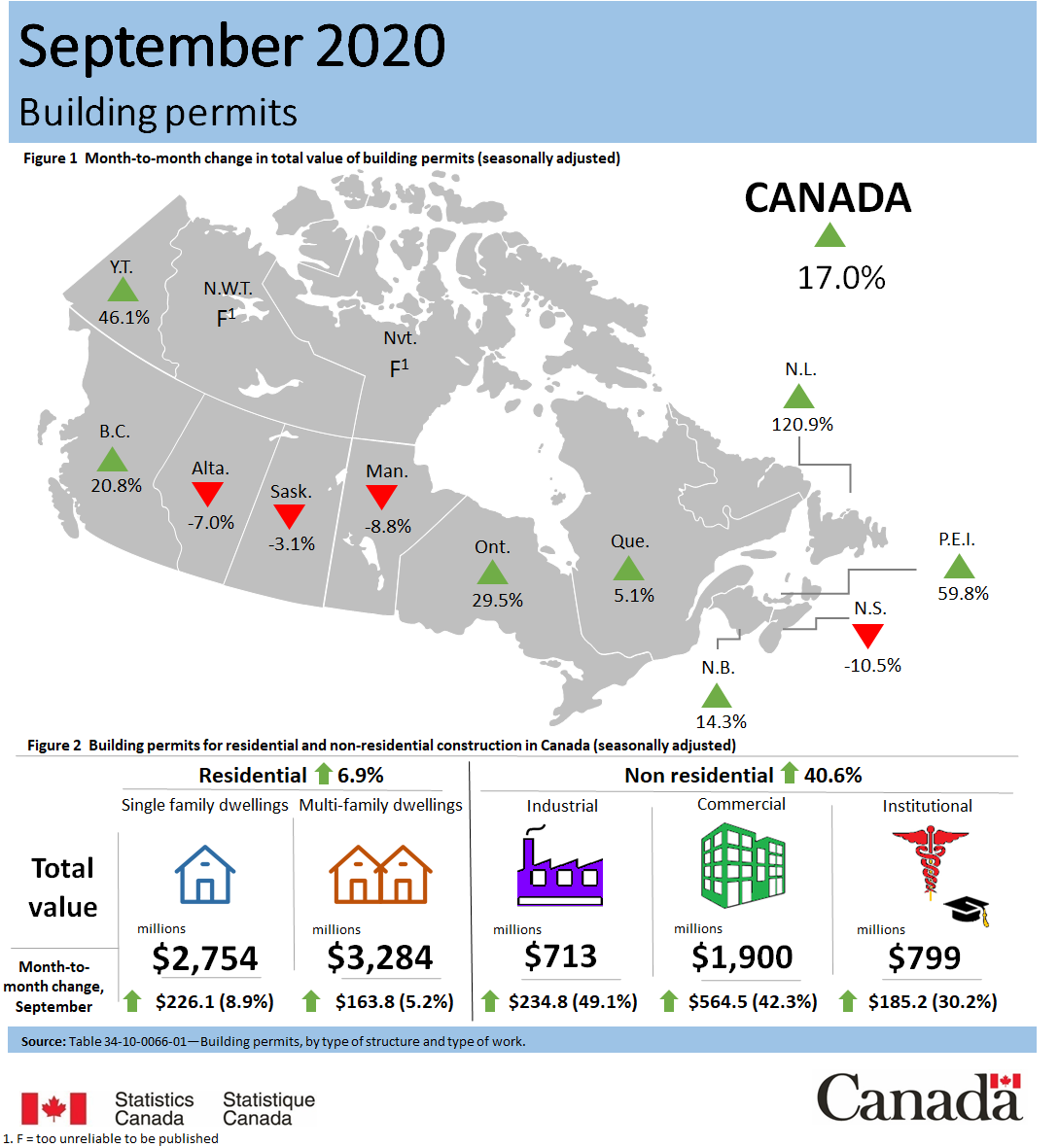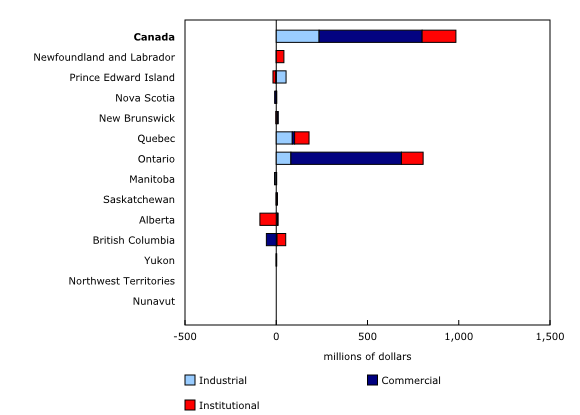Building permits, September 2020
Archived Content
Information identified as archived is provided for reference, research or recordkeeping purposes. It is not subject to the Government of Canada Web Standards and has not been altered or updated since it was archived. Please "contact us" to request a format other than those available.
Released: 2020-10-29
$9.4 billion
September 2020
17.0% 
(monthly change)
$80.4 million
September 2020
120.9% 
(monthly change)
$94.7 million
September 2020
59.8% 
(monthly change)
$114.6 million
September 2020
-10.5% 
(monthly change)
$97.2 million
September 2020
14.3% 
(monthly change)
$1,869.7 million
September 2020
5.1% 
(monthly change)
$4,654.7 million
September 2020
29.5% 
(monthly change)
$243.3 million
September 2020
-8.8% 
(monthly change)
$101.1 million
September 2020
-3.1% 
(monthly change)
$836.3 million
September 2020
-7.0% 
(monthly change)
$1,345.1 million
September 2020
20.8% 
(monthly change)
$10.1 million
September 2020
46.1% 
(monthly change)
$2.3 million
September 2020
F
(monthly change)
F
September 2020
F
(monthly change)
All sectors observed gains in the total value of building permits issued in September, which rose 17.0% to $9.4 billion. Over three-quarters of this growth came from permits issued in Ontario. With COVID-19 cases rising in many regions in September, some municipalities reported that builders have begun to submit applications earlier as a precaution against potential shutdowns.
Ontario and British Columbia drive residential growth
The total value of residential permits issued in September, including single family and multi-family dwellings, increased 6.9% to $6.0 billion.
The value of permits issued for single family homes rose 8.9% to $2.8 billion in September, led by Ontario (+18.0%). This was the fifth consecutive monthly gain reported in the province, outweighing the declines posted in six other provinces.
Five provinces reported an increase in the value of permits issued for multi-family dwellings, lifting the national total by 5.2% to $3.3 billion. British Columbia (+49.1%), after two months of decline, led the nation in growth in this component.
Ontario permits make up over half of the value in the non-residential sector
The total value of non-residential permits was up 40.6% to $3.4 billion in September, mostly attributable to large projects in Ontario (+$805 million).
Additional permits for Project Python in the city of Ottawa and the Breithaupt Block office building in the city of Kitchener, contributed to a 42.3% rise in the value of commercial permits nationally, increasing the total to $1.9 billion.
The value of permits issued for industrial buildings rose in eight provinces, breaking the downward trend observed over the previous three months. Permits issued in Quebec, Ontario and Prince Edward Island drove the increase of 49.1% to $713 million nationally.
Following two months of declines, the value of institutional permits expanded by 30.2% to $799 million. A $130 million permit issued for major renovations to the Centre Hospitalier Universitaire de Sherbrooke in Quebec and several permits issued for the new construction of nursing homes and senior citizen homes in Ontario contributed to the increase in this total.
Quarterly levels near those observed in the fourth quarter of 2019
Following four consecutive quarters of decline, the value of building permits jumped 16.5% in the third quarter of 2020, almost returning to levels observed in the fourth quarter of 2019. This was the largest gain since the fourth quarter of 2009 when the economy was recovering from the 2008 financial crisis, and possibly reflected the issuance of permits previously delayed as a result of COVID-19.
All sectors posted gains in the value of permits issued in the third quarter of 2020, with the residential sector soaring to record levels. Residential permits rose 16.8% to $16.9 billion, the highest level since the start of the modern series which dates back to 2002.
Multi-family dwellings drove this upward movement, climbing back to just under the $9.4 billion peak reached in the second quarter of 2019.
In recent years, permits for single family homes have been declining slightly, but in the third quarter, they jumped 36.7% to levels not seen since the first quarter of 2018. As teleworking has become the new normal for many people during the pandemic, the desire for more space may be shifting consumer demand towards single family homes.
To explore the impact of COVID-19 on the socioeconomic landscape, please visit the Canadian Economic Dashboard and COVID-19.
For more information on housing, please visit the Housing statistics portal.
Statistics Canada has a Housing Market Indicators dashboard. This web application provides access to key housing market indicators for Canada, by province and by census metropolitan area. These indicators are updated automatically with new information from monthly releases, giving users access to the latest data.
Note to readers
Unless otherwise stated, this release presents seasonally adjusted data, which facilitate month-to-month comparisons by removing the effects of seasonal variations. For information on seasonal adjustment, see Seasonally adjusted data – Frequently asked questions.
The Building Permits Survey covers over 2,400 municipalities, representing 95% of the Canadian population. The communities representing the other 5% of the population are very small, and their levels of building activity have little impact on the total for the entire population.
Building permit data are used as a leading indicator of activity in the construction industry.
The value of planned construction activities presented in this release excludes engineering projects (such as waterworks, sewers or culverts) and land.
For the purposes of this release, the census metropolitan area of Ottawa–Gatineau (Ontario and Quebec) is divided into two areas: the Ottawa part and the Gatineau part.
Unless otherwise specified, the highlights refer to seasonally adjusted current dollars and are ranked in terms of dollar change rather than percentage change.
Building components
Single-family dwellings: Residential buildings containing only one dwelling unit (for example, single-detached house, bungalow, linked home [linked at the foundation]).
Multi-family dwellings: Residential buildings containing multiple dwelling units (for example, apartment, apartment condominium, row house, semi-detached house).
Industrial buildings: Buildings used in the processing or production of goods, or related to transportation and communication.
Commercial buildings: Buildings used in the trade or distribution of goods and services.
Institutional and government buildings: Buildings used to house public and semi-public services, such as those related to health and welfare, education, or public administration, as well as buildings used for religious services.
Revision
Unadjusted data for the current reference month are subject to revision based on late responses. Data for the previous two months have been revised. Seasonally adjusted data for the previous three months have also been revised.
Trend-cycle estimates have been added to the charts as a complement to the seasonally adjusted series. Both seasonally adjusted data and trend-cycle estimates are subject to revision as additional observations become available. These revisions could be large and could even lead to a reversal of movement, especially at the end of the series. The higher variability associated with trend-cycle estimates is indicated with a dotted line on the chart.
For information on trend-cycle data, see the StatCan Blog and Trend-cycle estimates – Frequently asked questions.
Contact information
For more information, or to enquire about the concepts, methods or data quality of this release, contact us (toll-free 1-800-263-1136; 514-283-8300; STATCAN.infostats-infostats.STATCAN@canada.ca) or Media Relations (613-951-4636; STATCAN.mediahotline-ligneinfomedias.STATCAN@canada.ca).
- Date modified:






